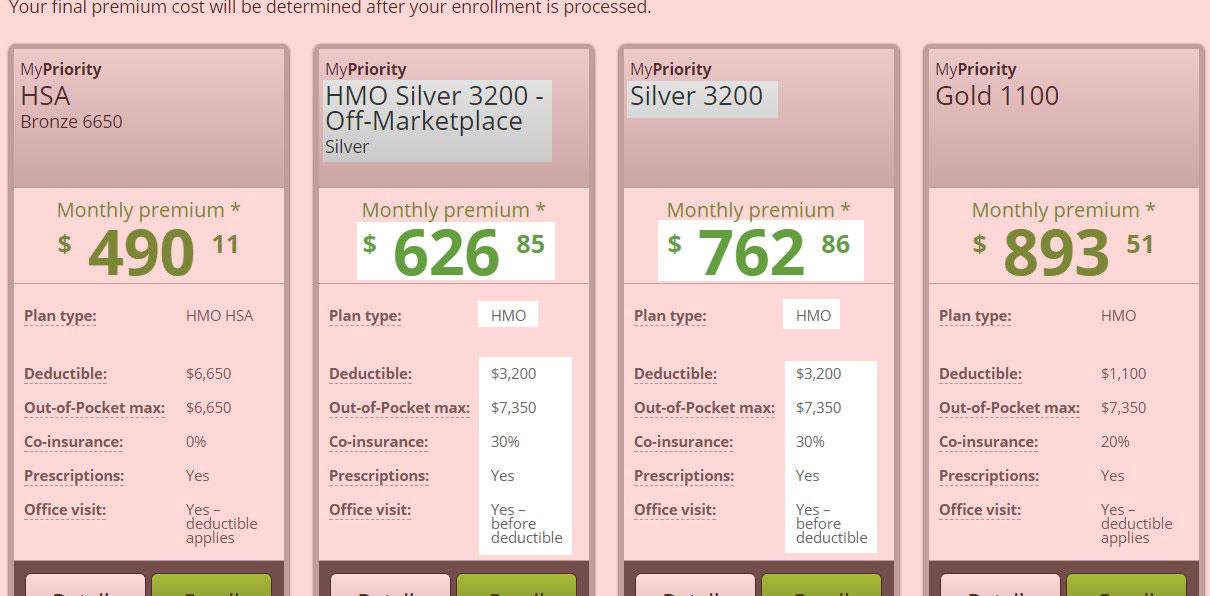IMPORTANT CAVEAT about choosing an off-exchange plan: Only do it if you KNOW you won't qualify for tax credits!
No one has been promoting the Silver Switcharoo option (in states which allow it) louder or more emphatically than I have for the past few weeks.
To summarize (again), this is where someone whose household income is too high for them to qualify for ACA tax credits (400% of the Federal Poverty Line) chooses an ACA-compliant off-exchange Silver plan instead, which is either identical or nearly identical to the same on-exchange policy in every way except that the additional CSR load hasn't been tacked onto it.
Here's a perfect example found by Louise Norris...ironically, this is via Priority Health here in Michigan, which (until today) I thought was a "Silver Load" state, not "Silver Switcharoo". I'll have to do some more research to be sure, but it sounds like at least one MI carrier (Priority) is going full Switch:
As you can see, sure enough, they list two "HMO Silver 3200" plans with the exact same deductible and out of pocket maximum...but one of them is specifically labelled "Off-Marketplace", and costs a whopping $136/month less. In this situation, an enrollee who doesn't qualify for ACA tax credits would save $1,632 next year by going off-exchange instead of on exchange.
In fact, I heard of a real-world example just this morning:
Just looked. Up 300 on exchange, 70 off. Thanks to you I know about silver switcharoo!
— colleen (@karlasu2) November 1, 2017
Yep. Same silver plan.
— colleen (@karlasu2) November 1, 2017
This woman did even better: Her premiums are going up $70/month next year ($840 total), which obviously isn't great...but by moving to the off-exchange equivalent, she's going to save $230/month, or $2,760!
OK, so aside from it being kind of confusing and a bit intimidating, what's the downside to doing this?
 Well, as Norris explains, as long as it's a fully ACA-compliant policy, there's only one big one to look out for:
Well, as Norris explains, as long as it's a fully ACA-compliant policy, there's only one big one to look out for:
It’s also important to note that if you begin the year with an income that isn’t subsidy eligible and then your income drops during the year to a level that would make you eligible for a subsidy, you would only be able to start getting a subsidy at that point if you were already enrolled in an exchange plan. If you renew your off-exchange plan, or opt for an off-exchange plan during open enrollment, you won’t be able to switch to a subsidy-eligible exchange plan until the next open enrollment, regardless of any mid-year changes in your income (a qualifying event would allow you to switch plans, but a change in income is not a qualifying event if you’re not already enrolled in the exchange).
In other words: ONLY do the Silver Switcharoo if you're certain that your household income WON'T drop below 400% FPL.
Let's say someone lives by himself and earns $49,000/year. As you can see in the table, 400% FPL in every state except Alaska and Hawaii is $48,240 next year (let's assume he lives here in Michigan). He's pretty sure his 2018 income will be at least $49K or higher, so he assumes he won't qualify for tax credits.
He hears about the Silver Load/Silver Switch option and decides to take a look at Priority Health as shown above. Hey, neat...he can save $1,600 by going with the off-exchange Silver option! All is well, right?
So far, so good.
HOWEVER, what if he has a crappy year? Halfway through the year he realizes that he's on track to only earn about $45,000 by the end of 2018.
While this is a bummer for his bank account, the silver lining (hah!) is that he's down to just 373% FPL and now qualifies for tax credits, right?
Wrong. The problem is that, as Norris explained, he would have had to enroll in the on-exchange plan since the beginning of the year. Tax credits are only available if you enroll through the ACA exchange itself (or via an authorized Proxy Direct Enrollment vendor, whose systems are integrated with the HC.gov back end), and you aren't allowed to switch plans (even if it's only from "off exchange" to "on exchange" for the same plan) mid-year.
The guy in question would be stuck without tax credits until 2019, at which point he can decide how to proceed again.
Of course, he could still be better off with the off-exchange plan anyway; it's possible that he would only qualify for, say, $1,000 in tax credits anyway, so he'd still come out $600 ahead.
Even so, I strongly recommend only going with an off-exchange option if you're certain that you won't be eligible for tax credits next year. If you think you might fall below that threshold after all, I'd still lean towards the on-exchange option just in case.
Oh, and once again: The FPL income amount is going up next year, so some people who didn't qualify for tax credits in 2017 will in 2018 even if their income stays exactly the same, so double check to be sure!




